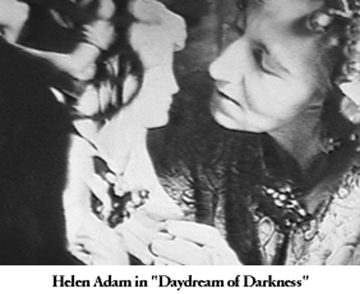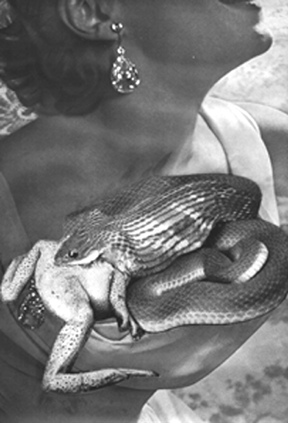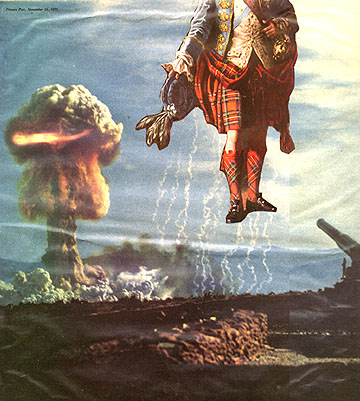 |
|
 "... if she was married to anyone, it was to her imagination."  |
Helen Adam's Sweet Company, cont.
by Kristin Prevallet  Adam's sexuality, which is inadvertently reflected in these collages, was complicated. She adored women, and idolized the female form. When she was younger she filled thick scrapbooks with movie stars and photographs of ballerinas from the Ballet Russes. She took photographs of herself posing, mimicking the beauties she worshipped. As she grew older, she collected art nouveu statues of women. In her wild montage film, Daydream of Darkness, these statues emerge from the sea and have mythic love affairs with mortals on the beach. In one scene she kisses a statue, a gesture revealing in its tenderness of how her true love lies somewhere between flesh and marble. On a slip of paper she writes: "That woman I saw in a stone / Keeps pace when I walk alone."  Yet, she was not a lesbian. She lived with her sister Pat for the entirety of her life. Neither married, although Pat desperately wanted out from the artistic confines of a weird spinster's life. But every time she brought home a male suitor, Helen would insult and make fun of him. She once told a friend of hers that in Egyptian culture a woman could marry her sister, and that she believed that taboos against incest are against nature. But if she was married to anyone, it was to her imagination. It was there that she found her ideal mate, a being who lived between the worlds of the living and the dead. As with other female artists of the 20th century -- such as Claude Cahun and Maya Deren -- Adam represents a gender that is neither male nor female. She theatricalizes femininity to such an extreme that the designation "woman" no longer applies. Ultimately, her collages give birth to another breed of woman all together--one that is informed by male expectations of beauty, but simultaneously subverts objectification.  But it has to be said that ultimately, Adam was not interested in human beings. She detested mankind for creating the Atom bomb, and for destroying nature. By depicting men as childlike, silly creatures who shoot out of the sea or are reduced to cowering infants, Adam makes a dramatic statement about who really holds the power. Like the Ancient Mariner, she believed that one day the creatures of the earth would emerge and take their revenge against the atrocities of mankind. Perhaps, as in the science-fiction stories she adored, the earth should be populated by alien-human hybrids. To Adam, there was no need to go to outer space to find aliens. They exist here on earth in the guise of insects, bats, and rodents--those creatures which humans fear as much as we do anything that is radically different from ourselves. | ||
|
[the work] [diner] [dialogue] [theory & practice] [opportunities] [archives] Volume Two, # Two ©1999 - 2000 |